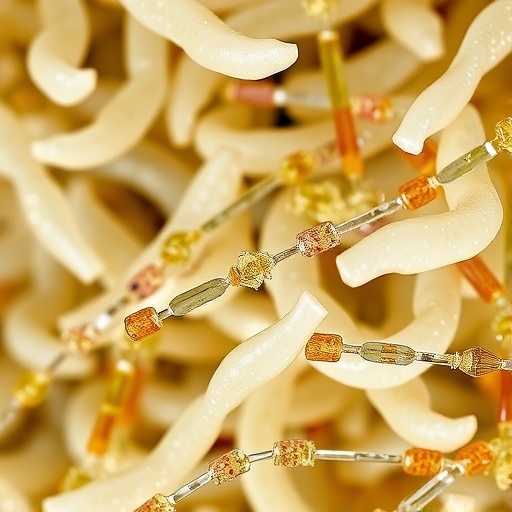In a groundbreaking pilot study, researchers have unveiled compelling evidence of microplastics within human feces, opening new frontiers in understanding the pervasive reach of plastic pollution and its potential impact on human health. The investigation, conducted by Refosco, Dierkes, Kögel, and colleagues, meticulously explores the relationship between dietary habits and the presence of microplastics, signaling a crucial step toward deciphering how everyday consumption patterns might contribute to plastic ingestion.
Microplastics—tiny plastic particles less than 5 millimeters in size—have become a ubiquitous environmental contaminant, found in oceans, freshwater systems, soil, and even the air we breathe. Until recently, most studies focused on ecological consequences for marine organisms and terrestrial wildlife. However, this new research directly addresses the human dimension, confirming that these microscopic synthetic particles not only permeate the environment but are also making their way into the human gastrointestinal tract.
The pilot study employed rigorous analytical methodologies to quantify microplastic content in fecal samples collected from a diverse cohort of participants. By combining advanced micro-spectroscopic and thermal analysis techniques, the researchers identified multiple types of plastic polymers, ranging from polyethylene to polystyrene. This methodological robustness ensured precise differentiation between plastic particles and other organic or inorganic debris, setting a benchmark for the reliability of future human microplastic studies.
Diet emerged as a significant variable influencing microplastic ingestion. Participants with diets rich in seafood, processed foods, and packaged products exhibited higher microplastic loads. This finding aligns with prior ecological observations that microplastics accumulate in the food chain, particularly within marine organisms. Additionally, the study draws attention to a less explored source: microplastic contamination originating from food packaging materials and utensils, which could inadvertently contribute to ingestion during meal preparation and consumption.
The implications of these findings extend well beyond mere presence. Scientists are increasingly concerned about microplastics’ potential to cause localized inflammation, alter gut microbiota composition, or even translocate across the intestinal barrier into systemic circulation. While the pilot study does not directly assess physiological impacts, it raises urgent questions about long-term effects given the chronic exposure implied by the regular detection of microplastics in human excreta.
Moreover, this research accentuates the intersection of environmental health and human nutrition, suggesting that tackling microplastic exposure might require integrative strategies involving both pollution mitigation and dietary interventions. For instance, advocating for reduced consumption of single-use plastics and processed foods could serve dual purposes of protecting both planetary and personal health.
The study also highlights the need for standardized methods in microplastic detection within human biological matrices. Variabilities in sampling, processing, and analytical approaches currently challenge cross-study comparisons. By demonstrating a clear, replicable protocol, the researchers not only provide foundational data but also encourage the scientific community to adopt harmonized methodologies to advance this emergent field.
Importantly, the investigation transcends typical environmental science boundaries by incorporating sociological and behavioral dimensions. Through detailed dietary assessments and participant interviews, the research contextualizes microplastic exposure within everyday life choices, emphasizing human agency and the potential for behavioral change to mitigate risk.
In parallel, the study demands that policymakers take note. Regulatory frameworks governing food safety and plastic use may need to evolve in light of accumulating evidence pointing toward human microplastic ingestion. Such policy shifts could include stricter controls on microplastic emissions, enhanced food packaging standards, or public health advisories surrounding consumption patterns.
While the pilot nature of the study limits broad generalizations, it undeniably sets the stage for larger, more comprehensive studies. Subsequent research with expanded participant pools and longitudinal designs will be essential to verify trends, elucidate mechanisms, and clarify health outcomes related to microplastic exposure in humans.
Furthermore, the investigative team advocates for multidisciplinary collaboration, bringing together toxicologists, nutritionists, materials scientists, and clinicians to holistically address the complexities posed by microplastics. Such partnerships could accelerate the translation of research findings into tangible health guidelines and environmental policies.
The revelation that microplastics consistently appear in human feces underscores a fundamental truth about the current era: plastic pollution is not just an environmental issue but a pervasive human health concern. As plastic materials continue to infiltrate virtually every facet of daily life, understanding their full impact on human biology becomes imperative.
In the broader context of planetary health, this study serves as a clarion call for urgent innovation in sustainable materials, waste management, and consumer behaviors. The potential for microplastics to act as vectors for harmful chemical additives or microbial pathogens further complicates the risk landscape and amplifies the urgency for remedial action.
As society grapples with the ramifications of the Anthropocene, the findings by Refosco and colleagues offer both caution and hope. They caution that invisible plastic particles have already breached human biological systems, and hope that through diligent scientific inquiry, informed public engagement, and decisive policy, the tide of microplastic contamination can be stemmed.
In essence, the study illuminates an emerging frontier in human health research, where environmental contaminants intersect with lifestyle and biological vulnerability. Its viral dissemination will likely stimulate wide-ranging discourse across scientific, medical, and public arenas, propelling urgent conversations about the invisible plastic particles that now silently accompany our every meal.
Subject of Research:
Microplastics presence in human feces and their links with dietary habits.
Article Title:
Microplastics in human feces: a pilot study exploring links with dietary habits.
Article References:
Refosco, A., Dierkes, J., Kögel, T. et al. Microplastics in human feces: a pilot study exploring links with dietary habits. Micropl.& Nanopl. 5, 22 (2025). https://doi.org/10.1186/s43591-025-00129-6
Image Credits:
AI Generated
DOI:
https://doi.org/10.1186/s43591-025-00129-6




